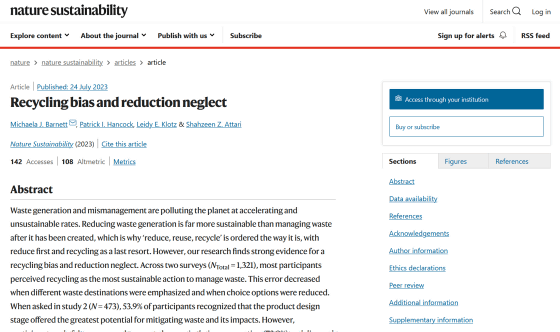Pointed out that the call to the general public to ``recycle garbage'' is making sustainable waste management difficult

Since childhood, many people have been taught to 'separate garbage properly and recycle', and some people think that recycling is the most important thing to solve the garbage problem of the earth. However,
Recycling bias and reduction neglect | Nature Sustainability
https://doi.org/10.1038/s41893-023-01185-7

Decades of public messages about recycling in the US have crowded out more sustainable ways to manage waste
https://theconversation.com/decades-of-public-messages-about-recycling-in-the-us-have-crowded-out-more-sustainable-ways-to-manage-waste-208924
Some people think that most human waste can be recycled, but it's actually not that simple. At first glance, the ``paper cup for take-out coffee'' cited by Barnett et al. It is difficult for consumers to separate the paper part and plastic, and it is not suitable for recycling.
Many experts agree that humans are generating unmanageable and unsustainable amounts of waste , and microplastics released from plastic waste are polluting every corner of the world. It has already been reported that microplasticshave been found in human blood , and it has become clear that 90% of commercially available salt contains microplastics .
A paper published in May 2023 showed that microplastics are not only generated when plastics are discarded, but are also released in large amounts during the process of recycling plastics .
The most effective way to solve the problems surrounding these wastes is not to recycle them, but to eliminate them in the first place. The figure below is a framework called 'Waste Management Hierarchy' adopted by the United States Environmental Protection Agency and others, and is regarded as an environmentally preferable waste solution in order from the top. The top ``Reduction & Reuse of Resources'' corresponds to `` Reduce & Reuse'' of the ``Reduce, Reuse & Recycle'' that we often hear, and ``Recycle & Compost'' is the second most environmentally friendly solution. It is In fact, there is a difference in environmental priority between 'reduce and reuse', which reduces the amount of waste itself, and 'recycle,' which reuses waste.

Indeed, recycling is a greener solution than burning waste in incinerators, filling landfills, or burning waste to extract energy. However, since recycling resources requires energy and additional resources, it has a greater negative impact on the environment than reducing the generation of waste itself by reducing and reusing, Barnett and others point out. .
Mr. Burnett and others conducted a questionnaire survey on the effectiveness of strategies to manage waste and investigated how well the correct perception of waste management is rooted among people. As a result, in an open-ended question asking about 'the most effective way to deal with the problem of waste,' most people perceive recycling as the most sustainable solution, indicating that It turns out that 'recycling bias' exists. In addition, only 78% of the respondents were able to correctly rank combinations of waste management hierarchies, suggesting that messages to the public appealing for recycling may be confusing people about waste management. I was.
On the other hand, in the question to rank the priority of 'Reduce, Reuse, Recycle', the number of subjects who got the priority wrong decreased to 46%, and in the two-choice question of 'Disposal Prevention' and 'Recycling', more than 80% were discarded. It is said that it was possible to recognize that it is more environmentally friendly to prevent it.
In addition, in a test in which general household waste was divided into ``recyclable'' and ``non-recyclable'', many people answered ``plastic bags (58%)'', ``disposable coffee cups (46%)'', and ``disposable coffee cups (46%)''. They answered that they can recycle garbage that is difficult to recycle, such as light bulbs (26%). By throwing away items that cannot be recycled as recyclable waste, there is a risk that recycling companies will have to pay the cost of re-sorting them, or that even recyclable waste will be landfilled because it is determined to be unrecyclable. About.
On the other hand, the average answer to the question 'What percentage of plastics have been recycled since the start of production?' It also turned out that most of them are aware that they are not recycled. A widely quoted estimate of '

Barnett and others point out that existing waste-tackling messages point to 'consumers' as sources of waste, making it appear that much of the responsibility lies with them. However, in reality, most of the responsibility for generating waste lies with the company that produces the product, and by developing a product collection system and designing products that are easy to recycle, the waste problem can be dealt with more effectively. matter.
“Far from reducing the amount of single-use products, companies continue to blame consumers for their responsibility as the world becomes increasingly polluted by waste,” Barnett et al. is not an indulgence for overproduction and overconsumption.'
Related Posts:
in Science, Posted by log1h_ik







